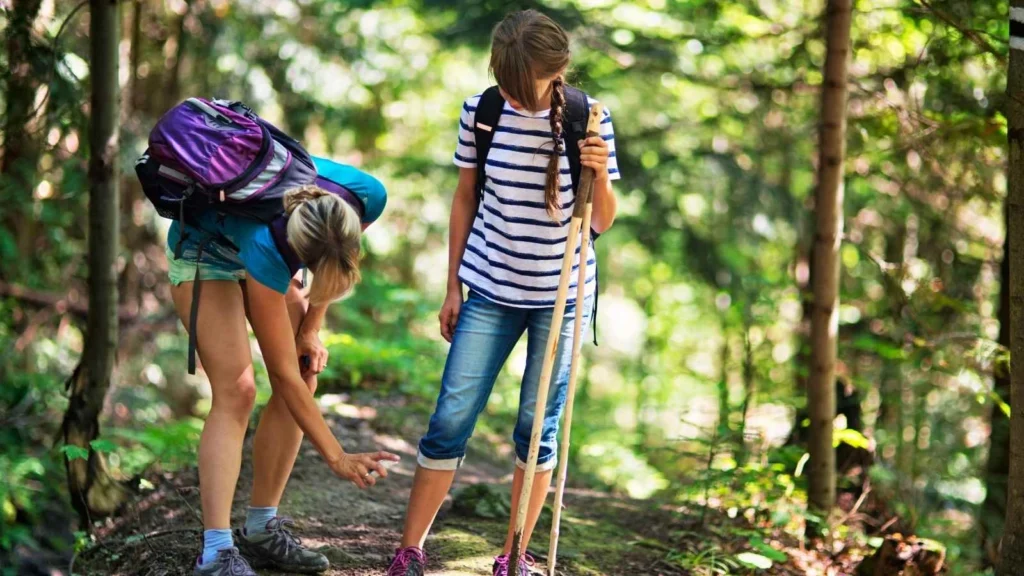How to Avoid Ticks while Hiking? 7 Tips For Preventing Tick Bites!

So you are dreaming about solo hiking trips? Breathtaking views? Awesome! But hold on… Afraid of tiny blood-sucking hitchhikers? I got you! In recent years, hiking has become one of the fastest-growing outdoor recreational activities among nature enthusiasts.
At the same time, the risk of hiking-related problems including tick bites is also increasing. Tick bites are popular for causing severe illness, including Lyme disease.
You can estimate the risk ratio from a CDC report that states that over 476,000 Americans are diagnosed with Lyme disease annually. The real horror? Unluckily, most of these cases were linked to outdoor activities like hiking.
Finally, some good news, now you can outsmart those little ticks. So, whether you are planning to experience the best hikes in Europe or the rest of the world, let’s ensure that you become a tick-repelling ninja!
Why Ticks Are a Concern for Hikers?
Ticks commonly inhabit grassy areas, including forests and fields, which hikers always choose as target destinations. While passing through these shrubs and woods, hikers can easily come in contact with ticks. Whether you’re traveling over thick forests or rejoicing coastal hikes in Spain, it is important to stay aware of the ticks.
Unfortunately, these tiny parasites, mainly the Lone Star tick, can transmit severe diseases through their biting. The Lone Star tick has become a major concern for hikers because of its aggressive biting. These ticks can transmit several serious diseases, including ehrlichiosis, because of their ability to carry bacteria, viruses, and protozoa.
The most common tick-borne diseases include Lyme disease and Rocky Mountain spotted fever. Lyme disease is caused by the hard-bodied ticks known as the black-legged ticks or deer ticks. These ticks cannot transmit Lyme disease to humans. Instead, they contain the specific infectious bacteria from the infected animals and then act as a vector for humans.
Luckily, deer ticks cannot transmit the infectious bacteria in minutes. They need at least 24 hours to transmit the bacteria to humans. Once the bacteria enter the body, they can cause serious adverse effects. At the early stage, a person feels only a headache, fatigue, fever, or joint pain. Later, these symptoms progress to arthritis, heart-related issues, and muscular stiffness.
Unfortunately, Lyme disease is difficult to treat because of the inability to diagnose the condition. It is because Lyme disease mimics many other illnesses. The best way to reduce the risk is to avoid the ticks. Therefore, you must take precautionary measures whenever planning to visit the high-risk areas.
Biting of the infectious tick develops mild symptoms including swelling, itching, bruising, blistering, headache, fever, rash, and joint pain. If left untreated, it can even lead to the death of the person. The worst news is that tick-borne illnesses have more than doubled in the past 13 years according to CDC reports. Therefore, prevention against ticks has become critical for hikers’ safety.
7 Tips to Keep Ticks Away when Hiking
As a hiker, you should have a thorough understanding of all international travel tips. Especially when planning for exciting hikes in the world, you need to know how to keep ticks off you. Let’s cut to the chase and keep the energy high.
1. Dress Up Properly
Block the ticks from coming in contact with your body by wearing long sleeves and pants. Tuck your pants into socks to close the clothes opening from the bottom. Further, make sure your shoes fit well enough to keep ticks out of your feet. You can also wear a hat to properly tuck in your hair. In addition to this, opt for light-colored clothes. Wearing light colors makes it easier to find and remove the crawling ticks on the body.
2. Use Tick Repellents
EPA-approved tick repellants have proven efficient for avoiding ticks while hiking. Therefore, any of the approved repellents such as Picaridin or DEET should be on your backpacking checklist. Apply the repellent on exposed skin areas before hiking.
Never apply repellent directly on the face, instead rub it in your hands first and then apply on the face. In addition, carefully read the instructions given with the repellent. You must know about the effectiveness, side effects, precautions, and shelf-life of the repellent before its application.
3. Spray The Permethrin
Permethrin is an insecticide widely used in hiking attire. But, do you know how to keep ticks away by using this insecticide? You can either buy permethrin-coated clothes from the market or spray it on the clothes by yourself.
If you are thinking of spraying permethrin by yourself, find an outdoor area. Hang your clothes with any hanging accessories and spray permethrin.
Let it dry completely in the open air and then pack it for your exciting journey. Besides clothes, you can also coat your hats, shoes, bags, and backpacks to get extra protection. Keep in mind that the effectiveness of permethrin precoating lasts for six weeks. After six weeks, you need to recoat your clothes.
4. Stay In Center Of The Trail
A larger number of ticks can be found in shady areas where moisture is present. It increases the risk of tick bites for the hikers in grassy and wooded areas. As well as leaf litter and fallen wood, edge habitats or transitional areas, stone walls, and dense vegetation are popular places for ticks to exist.
Due to this reason, staying in the center of the trial rather than a bushy and grassy area always remains a preferable decision. Keep in mind that ticks can easily be transmitted from pets to humans. Therefore, if you’re going with a pet on a hike, also keep them away from overgrown areas.
5. Do Frequent Tick Checks
After every short interval, check your body and clothes for ticks while hiking. Sometimes, you may be unable to spot ticks on your body because of their small size. To avoid such a situation, take a short break somewhere in the trial and feel for ticks on your skin. Closely check the specific body areas including the armpit, scalp, ears, knees, and bellybutton. You can also use any tick removal tool from your travel essentials to keep ticks off of you. Whether you’re planning a challenging trek like hiking in the Pyrenees or simply exploring local trails, being prepared for ticks is a vital part of enjoying the outdoors safely.
6. Avoid Hiking During Certain Months
The ticks remain active throughout the year, but the season between March and October is considered most favorable for ticks. During this duration, the weather remains wet and hot. The high temperature usually favors the breeding of the ticks and increases their number.
Similarly, wet weather helps ticks to keep their bodies hydrated. Both of these conditions accelerate the tick growth, thus increasing the risk of their bites. Therefore, it can be the best idea to plan your hiking during the period between November and February.
7. Dry Your Clothes At High Temperature
There is no doubt that the tips we discussed earlier can help you avoid ticks, but you should still treat your clothes to ensure complete tick removal. Studies have shown that drying clothes at a high temperature for at least 10 minutes can kill the ticks.
So, whenever you return from hiking, dry your clothes at a relatively high temperature before washing. For efficient outcomes, you can also use hot water for washing purposes.
What to Do If You Find a Tick
While people look up tips to calm themselves before a flight, the first thing you have to do when you find a tick is to stay calm. A tick cannot transmit the pathogen until it’s attached or fed from your skin. So, if you find a tick crawling on your body, follow the following steps to remove it:
- Get the pointed tick removal tweezer as close as possible to the skin and grasp the tick. Never try to touch the tick with bare hands.
- Pull the tick with gentle force without squeezing and jerking. The mouth part of the tick should not be broken when pulling it upward.
- Place the tick with the same tweezer in a close plastic bag. Discard it by putting it in alcohol, wrapping it tightly with tape, or flushing it in the toilet.
- Wash your hands and clean the bite area with an antiseptic or alcohol swab. Check the bite area if any rashes or related symptoms are appearing there.
- Visit your doctor immediately if you notice any acute to mild symptoms within several weeks after a tick bite.
- Don’t hesitate to contact your doctor for prophylaxis of the tick bite even if you’re not getting any adverse symptoms.
Final Thoughts
No doubt, hiking is a refreshing and exciting activity, but addressing its complications, particularly tick bites, is crucial. This guide must have helped you to find how to repel ticks while hiking. You can protect yourself by wearing proper clothes, using repellents, and avoiding tick-concentrated areas. Further, if you find a tick on your body, carefully remove and discard it. Monitor your symptoms for weeks and seek medical help if necessary.











